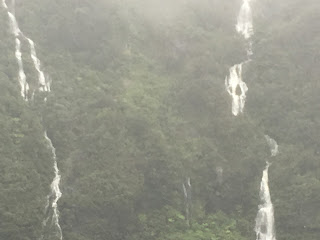Milford Sound.
It was VERRRRY EARRRRLY when we arrived in New Zealand so there was a lot of early morning mist as we sailed into Milford Sound, but as it was raining we had the bonus of a lot of waterfalls.
Described by Rudyard Kipling as the 'eighth wonder of the world', Milford Sound was carved by glaciers during the ice ages. Milford Sound is breathtaking in any weather. The fiord's cliffs rise vertically from the dark waters, mountain peaks scrape the sky and waterfalls cascade downwards, some as high as 1000 metres. When it rains in Milford Sound, and it often does, those waterfalls multiply with magnificent effect.
Doubtful Sound
The mist had cleared when we reached Doubtful Sound. It was given its name by Captain Cook who wasn't sure if the fjord was crescent shaped or if the boat would have to turn around and come back.
Sometimes called the 'Sound of Silence' Doubtful Sound is the deepest (421 metres) and second longest (40 kilometres) of the South Island's fiords. The powerful serenity of the fiord, named Doubtful Harbour by Captain James Cook, who didn't sail into the inlet because it looked a bit tight, contrasts with the nearby Milford Sound.
Dusky Sound
By lunchtime, we had reached Dusky Sound and from the front of the ship it looked spectacular.
The inlet was first sighted by Europeans and Captain Cook noted its entrance during his first voyage to New Zealand in 1770. He named it Dusky Bay. On his second expedition he spent two months exploring the sound, and used it as a harbour, establishing workshops and an observatory.











No comments:
Post a Comment